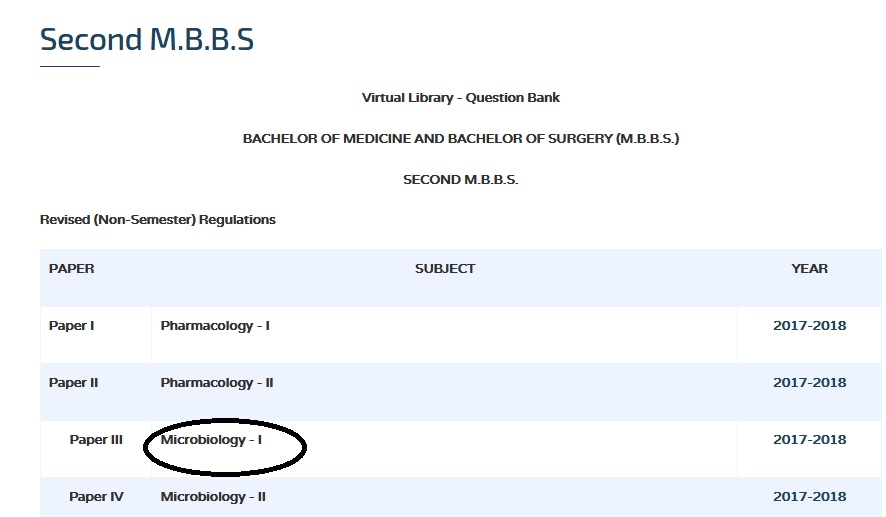TNMGRMU Virology, Mycology, Parasitology & Applied Microbiology Second MBBS Question Bank
Name of the University : The Tamilnadu Dr. M.G.R. Medical University
Degree : Second M.B.B.S
Subject Code/Name : 4062 Virology, Mycology, Parasitology & Applied Microbiology
Paper : II
Document Type : Question Bank
Website : web.tnmgrmu.ac.in
Download Model/Sample Question Paper :
2008-2014 :https://www.pdfquestion.in/uploads/we…6-524062LA.pdf
2003-2008 :https://www.pdfquestion.in/uploads/we…6-524062KU.pdf
TNMGRMU Microbiology Question Bank
Download 4062 Virology, Mycology, Parasitology & Applied Microbiology question paper from the above pdf Link.
I. Essay Questions : (2 x 15 = 30)
Related / Similar Question Bank :
TNMGRMU MBBS General Microbiology Question Bank
August 2008
1. Describe the morphology, life cycle, pathogenesis, and laboratory diagnosis of Echinococcus granulsosus.
2. Classify Herpes Viruses. Describe the morphology, pathogenesis and laboratory diagnosis of acute Herpes Simplex virus.

II. Write Short notes on : (10 x 5 = 50)
1. Morphology and laboratory diagnosis of kalaazar.
2. Laboratory diagnosis of Urinary Tract Infection.
3. Differences between ortho myxo and Paramyxo viruses.
4. Sporotrichosis.
5. Cryptosporidium parvum.
6. Coxsachie Viruses.
7. Universal Precautions.
8. Primary amoebic meningoencephalitis
9. Cryptococcus neoformans.
10. Microfilaria.
III. Short Answer Questions : (10 x 2 = 20)
1. Vaccines against polimyelitis.
2. Four arbovirus infections prevalent in India.
3. Delta Hepatitis agent.
4. Draw the ovum of Enterobius vermicularis.
5. Two parasites infecting the eye.
6. Name two parasites causing (a) Anemia and (b) Visual larva migrans.
7. Chlamydospore.
8. Name two fungi causing occulomycosis.
9. Enumerate four dermatophytes.
10. Four organisms causing Mycetoma.
February 2009
I. Essay Questions : (2 x 15 = 30)
1. Classify Rhabdo virus. Describe the pathogenesis, laboratory diagnosis and phophylaxis of rabies virus.
2. Classify nematodes. Describe the life cycle and laboratory diagnosis of ankylostoma duodenale.
II. Write Short notes on : (10 x 5 = 50)
1. Laboratory diagnosis of acute pyogenic meningitis.
2. Japanese ‘B’ encephalitis.
3. Oppurtunistic fungi.
4. Nosocomial infection.
5. Pathogenesis and laboratory diagnosis of Hydatid disease.
6. Methods of HIV transmission.
7. Exo erythrocytic schizogony
8. Laboratory diagnosis of fungal infections.
9. Viral Haemorrhagic fevers.
10. Varicella zoster.
III. Short Answer Questions : (10 x 2 = 20)
1. Name four DNA viruses.
2. Draw and label a bacteriophage.
3. Define definitive host. Give two examples.
4. Otomycosis.
5. Trichomonas Vaginalis.
6. Mention four species of candida.
7. Complications of ascariasis (roundworm infestation).
8. Define an intermediate host.
9. Mention three antifungal agents.
10. Complication of dengue virus.

August 2009
I. Essay Questions : (2 x 15 = 30)
1. Name the viruses infecting the liver. Write the morphology, pathogenesis lab diagnosis and prophylaxis of hepatitis B virus.
2. Name the Haemoflagellates. Write the morphology, life cycle, clinical features and lab diagnosis of kala azar.
II. Write Short notes on : (10 x 5 = 50)
1. Viral multiplication.
2. Mycetoma.
3. Interferons.
4. Chikungunya virus.
5. Free living amoebae.
6. Life cycle of Balantidium coli.
7. Life cycle of taenia solium.
8. Stool examination of parasitic infections.
9. Candidiasis.
10. Dermatophytes.
III. Short Answer Questions : (10 x 2 = 20)
1. Morphology of HIV virus.
2. Von magnus phenomenon.
3. Write four differences between salk and sabin vaccines.
4. Paul Bunnel test.
5. Draw the morphology of penicillium.
6. Name two pigment producing fungi.
7. Life cycle of taenia saginata.
8. Draw the diagram of ascaris egg.
9. N.N.N. Medium (Novy, Bicolle, Mcneal).
10. Name four oppurtunistic parasitic infections in AIDS.
February 2010
I. Essay Questions : (2 x 15 = 30)
1. Describe the lifecycle, pathogenesis and laboratory diagnosis Ascaris lumbricoides.
2. Describe the pathogenesis, laboratory diagnosis and prophylaxis of poliomyelitis.
II. Write Short notes on : (10 x 5 = 50)
1. Extra intestinal amoebiasis.
2. Complications produced by plasmodium falciparum.
3. Larva migrans.
4. Casonis test.
5. Diagnosis and prophylaxis of H1N1 infection.
6. Rhinosporidiosis.
7. Prions.
8. Interferon.
9. Dimorphic fungi.
10. Antigenic drift.
III. Short Answer Questions : (10 x 2 = 20)
1. Name four fungi causing opportunistic mycosis.
2. Fungi causing superficial mycosis.
3. Classify inclusion bodies.
4. Universal precautions.
5. Draw the diagram of microfilaria.
6. Name four parasites causing CNS infection.
7. Name the concentration methods of stool EXAMINATION
8. Kopliks spots.
9. Name the live viral vaccines.
10. Cryptosporidium.
August 2010
I. Essay Questions : (2 x 15 = 30)
1. Enumerate parasites causing Anemia. Describe in detail, morphology, life cycle and laboratory diagnosis of Anckylostoma duodenale.
2. Describe the morphology, pathogenesis and laboratory diagnosis of influenza virus.
II. Write Short notes on : (10 x 5 = 50)
1. Cytopathic effect.
2. Subcutaneous mycosis.
3. Dengue virus.
4. Life cycle of Entamoeba histolytica.
5. Dermatophytes.
6. Cryptococcus neoformans.
7. Toxoplasma gondii.
8. Cysticercus Cellulosae.
9. Life cycle of Ascaris Lumbricoidis.
10. Lab Diagnosis of Malaria.
III. Short Answer Questions : (10 x 2 = 20)
1. Three methods of cultivation of viruses.
2. Viral interferons.
3. Hepatitis markers.
4. Complication of neural vaccine.
5. Bile-Stained eggs.
6. Germ Tube Technique.
7. Diagram of Trichomonas – Vaginalis.
8. MMR.
9. Life cycle of Balantidium – coli.
10. Visceral larva migrans.